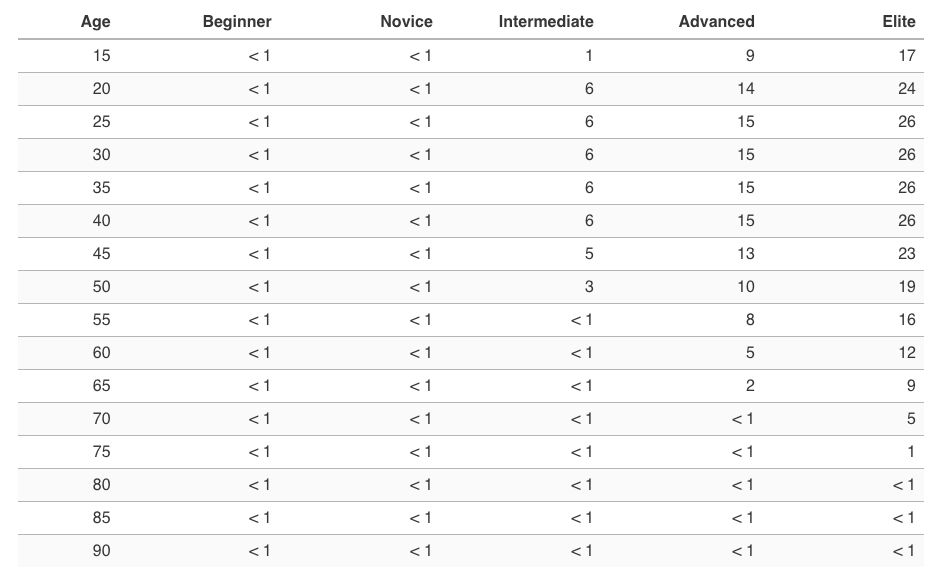Are you currently wondering: “How many pull ups should I be able to do”?
What’s considered an “average” number of pull-ups for men and women? And how does this change across different age groups and fitness levels?
Dive into this comprehensive guide to uncover the answers, and more importantly, discover how you can improve your own pull-up game.
Whether you’re a gym aficionado or just starting out, this article is your one-stop shop for all things pull-ups, blending insights, world records, and practical training tips. Get ready to elevate your fitness journey, one pull-up at a time.
Jump to:
Understanding Pull-Ups
Pull-ups. They’re not just an exercise; they’re a rite of passage in the fitness world. A pull-up is simple in concept but complex in execution. You grab a bar with an overhand grip and hoist yourself up until your chin is over that bar. Then lower back down and repeat – sounds easy, right? Not so fast.
What Makes Pull-Ups So Challenging?

Pull-ups are challenging due to a combination of factors including muscle mass, strength-to-weight ratio, age, gender, and fitness level.
- Muscle mass, particularly in the upper body, is crucial for lifting oneself, making men, who typically have more muscle mass, generally able to do more pull-ups than women.
- However, women can also achieve significant pull-up success with the right training.
- The strength-to-weight ratio plays a pivotal role; an imbalance can make pull-ups more difficult.
- Additionally, as one age, their pull-up ability may change, often decreasing over time.
- Finally, one’s fitness level significantly impacts their pull-up capability, with seasoned athletes likely able to perform more pull-ups than beginners.
Average Pull-Up Reps for Men, by Age and Fitness Level

Pull-ups aren’t just about heaving yourself up to a bar; they’re about strength, determination, and progress. Let’s break down what this looks like for the gents out there, across different ages and fitness levels. The info here is a goldmine from the folks at Strength Level, so let’s dive in!
Fitness Levels: From Beginner to Elite
- Beginner: Just starting out? No sweat if you’re not cranking out reps yet. For beginners, even one pull-up can be a big win.
- Intermediate: Here’s where things get spicy. If you’re at this level, you’re likely hitting a solid 14 reps.
- Advanced: Advanced means serious business – 25 reps. Yes, you read that right. That’s where strength meets stamina.
- Elite: The crème de la crème of pull-up prowess – 37 reps. It’s not just a workout at this point; it’s a performance.
According to Strength Level, here’s how many pull-ups you should be able to do based on your bodyweight:

The Current World Record For Men’s Pull ups

Speaking of performances, let’s talk world records. The current record holder is the amazing KENTA ADACHI from Japan, with a jaw-dropping 651 consecutive pull ups!
Age-Based Averages – A Timeline of Strength
- The Young Bucks (Under 18): Youngsters can surprise us. On average, teenagers can range from just a couple of reps to cranking out up to 8 reps as they approach 18.
- Peak Performance (18-30): This is typically the golden era of pull-up prowess. Men in this age group can average between 8-12 reps. It’s all about peak muscle mass and energy.
- The Steady Years (31-50): Things start to change a bit here. Men in this bracket might see a decline in reps due to lifestyle changes, but they’re still averaging a respectable 4-6 reps.
- The Wise Warriors (50+): Age is just a number, and these gents prove it. The averages might dip to 1-3 reps, but every rep is a testament to enduring strength.
Again according to Strength Level, here’s how many pull-ups you should be able to do based on your age:

Average Pull-Up Reps for Women, by Age and Fitness Level

Alright, ladies, it’s your turn to shine in the pull-up world. Pull-ups are often seen as a male-dominated exercise, but let’s flip that script. Women across the globe are redefining strength, one pull-up at a time.
Categorizing the Strength: From Newbies to Elite
- Beginner: Just starting your pull-up journey? If you’re hitting one rep, you’re right on track. It’s all about taking that first step… or pull.
- Intermediate: Getting into the groove, aren’t we? An average of 6 reps places you firmly in the intermediate zone.
- Advanced: Now we’re talking! Hitting 15 pull-ups? That’s advanced level. You’re not just pulling up; you’re holding your own.
- Elite: And for the elite among us – a whopping 26 reps. This is where grit meets grace, and every rep is a victory.
Here’s how many pull-ups you should be able to do based on your bodyweight:

The Current World Record For Women’s Pull ups
Let’s take a moment to appreciate the extraordinary women out there. The current world record for the most pull-ups in one minute by a woman is held by INGA SIMNING, who completed an astounding 39 pull-ups. Talk about setting the bar high!
Age-Specific Averages – A Journey of Strength
- Young and Fearless (Under 18): The younger crowd is starting strong, with teenagers managing between 1-3 reps. It’s about building that foundation.
- Prime Time (18-40): This is where many hit their stride. Averaging between 1-3 reps, women in this age group showcase their growing strength and endurance.
- Graceful and Gritty (40+): Who says strength fades with age? Women over 40 continue to impress, averaging around 1-2 reps. Each pull-up here tells a story of enduring strength.
Here’s how many pull-ups you should be able to do based on your age:

Age-Specific Averages
Pull-ups don’t discriminate by age – they’re a challenge for all, from the spry kids to the seasoned adults. Let’s break down how age plays a role in your pull-up game.
Children: The Budding Athletes
- Start ‘Em Young: For kids under 12, pull-ups are like climbing trees – it’s all fun and games, but also a building block for future strength. Boys in the 6-9 age range typically hit 1 pull-up, while 10-12-year-olds notch up to 2. Girls in these age groups often start developing their upper body strength through these early attempts.
Teenagers: The Rising Stars
- Teen Power: Teenage years are like the first big boss level in the game of pull-ups. Boys in their early teens (13-15) can often manage between 3-7 reps. By 18, they’re looking at around 8 reps. For girls, the teenage years are crucial for building strength, with averages ranging from 1-3 reps.
Adults: In Their Prime
- The Golden Years (18-40): This is where adults hit their peak. Men can average around 8-12 pull-ups, while women might be doing 1-3 reps. It’s all about maintaining muscle mass and leveraging strength.
- The Steady Phase (41-60): Not to be underestimated, adults in this age group may see a slight dip in their averages due to lifestyle changes, but they’re still going strong. Men often average 4-6 reps, and women can maintain 1-2 pull-ups with consistent training.
Older Adults: The Seasoned Warriors
- Age is Just a Number (60+): Who says you can’t rock pull-ups in your golden years? Men in this group often average 1-3 pull-ups, while women might manage 1 rep. Every rep in this age group is a testament to lifelong fitness and resilience.
Military Standards
When it comes to pull-ups, the military doesn’t play around. These exercises are a staple in military fitness tests, setting some tough but achievable standards. Let’s march through what it takes to meet the military muster when it comes to pull-ups, focusing on branches like the US Marine Corps and others.
The US Marine Corps: Where Pull-Ups Meet Grit
- The Bare Minimum: In the US Marine Corps, recruits must conquer at least 3 pull-ups. It’s the entry ticket to the world of Marine fitness.
- Aiming Higher: But here’s the kicker – to score a decent 50 percent on their fitness test, Marines have to complete 10 pull-ups. That’s not just strength; that’s determination.
The Test of Time and Strength
- Regular Assessments: Military personnel undergo physical fitness assessments either once or twice a year, depending on their branch. These tests are crucial, as they determine a service member’s fitness level and readiness for active duty.
- Beyond Just Reps: In the military, pull-ups are more than just a number. They’re a symbol of resilience, strength, and the ability to literally ‘pull yourself up’. It’s about being battle-ready, anytime, anywhere.
Factors Affecting Pull-Up Performance
So, you’re nailing your pull-up game or maybe you’re just starting out. Ever wonder what’s really influencing those reps? It’s not just about raw strength; several factors play a crucial role in your pull-up performance. Let’s break down the key players: body weight, muscle mass, and training.
Body Weight: It’s a Balancing Act
- Lighter Load, Easier Lift?: It might seem straightforward – the lighter you are, the easier to lift yourself, right? Not always. While a lower body weight can mean less to pull up, it’s not the whole story.
- Strength-to-Weight Ratio: This is where the magic happens. It’s about balancing your strength with your body weight. A perfect harmony here means more pull-up prowess.
Muscle Mass: The Power Behind the Pull
- Upper Body Strength: Pull-ups are a showcase of your upper body strength. More muscle mass, especially in your back, shoulders, and arms, can give you that extra oomph.
- Not Just Size, But Function: But hey, size isn’t everything. The functionality of that muscle mass matters too. It’s about how effectively you can use that muscle power.
Training: The Secret Sauce
- Consistency is Key: Regular training can transform your pull-up game. It’s like building a brick house – one brick at a time, one pull-up at a time.
- Technique Matters: It’s not just doing pull-ups but doing them right. Proper form can skyrocket your efficiency and effectiveness.
- Variety is the Spice of Life: Mixing up your training routine can also help. Incorporate different exercises to build the muscles involved in pull-ups.
Training Tips for Improving Pull-Up Repetitions

You’re pumped, ready to up your pull-up game. Whether you’re a newbie hanging onto the bar for dear life or a seasoned pro looking to level up, we’ve got some killer training tips to boost those reps. Let’s turn those pull-up dreams into a reality!
1. Start with the Basics
- For Beginners: Can’t do a full pull-up yet? No problem! Begin with assisted pull-ups using bands or a pull-up machine. This helps build foundational strength without overwhelming you.
- Master the Dead Hang: Spend time simply hanging from the bar. This builds grip strength, a critical but often overlooked component of pull-ups.
2. Strength Training: Building the Foundation
- Work on Related Muscle Groups: Exercises like lat pulldowns, rows, and bicep curls can strengthen your back and arms, key muscles in pull-ups.
- Don’t Forget the Core: A strong core stabilizes your body during pull-ups. Incorporate planks and other core exercises into your routine.
3. Perfect Your Form
- Focus on Full Range of Motion: Ensure you’re going all the way down and all the way up. Half-reps won’t cut it.
- Mind Your Grip: Experiment with grip width. A wider grip focuses more on the lats, while a narrower grip targets biceps.
4. Progressive Overload
- Gradually Increase Intensity: Once you’re comfortable with basic pull-ups, start adding weight with a belt or hold a dumbbell between your feet.
- Volume Training: Try increasing the number of sets or reps gradually over time, even if it means breaking them up throughout the day.
5. Consistency and Patience
- Regular Practice: Like any skill, mastering pull-ups requires consistent effort. Aim to include pull-up training 2-3 times a week.
- Rest and Recover: Don’t underestimate the power of recovery. Muscles need time to repair and grow stronger.
6. Mix It Up
- Vary Your Routine: Avoid hitting a plateau by mixing in different types of pull-ups, like chin-ups or commando pull-ups.
- Challenge Yourself: Set small, achievable goals to keep yourself motivated and track your progress.
References and Ressources:
- “The Pull-Up.” Strength and Conditioning Journal 36 (2014): 88-90.
- Upper body push and pull strength ratio in recreationally active adults. Int J Sports Phys Ther. 2013 Apr;8(2):138-44. PMID: 23593552; PMCID: PMC3625793.
- Association Between Performance in Muscle Fitness Field Tests and Skeletal Muscle Mass in Soldiers. Mil Med. 2020 Jun 8;185(5-6):e839-e846. doi: 10.1093/milmed/usz437. PMID: 31875898.
- https://strengthlevel.com/strength-standards/pull-ups/lb














